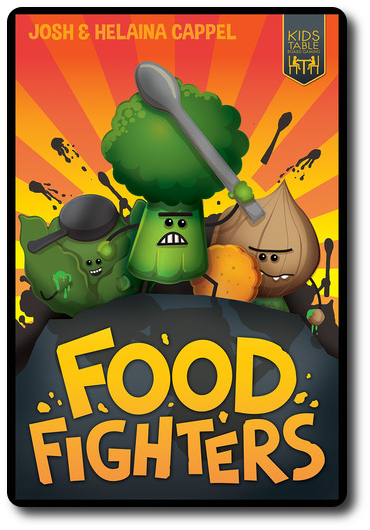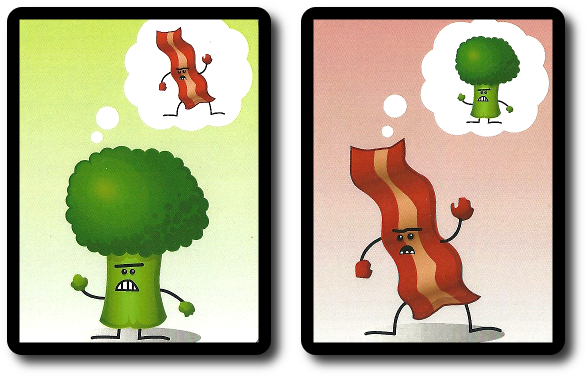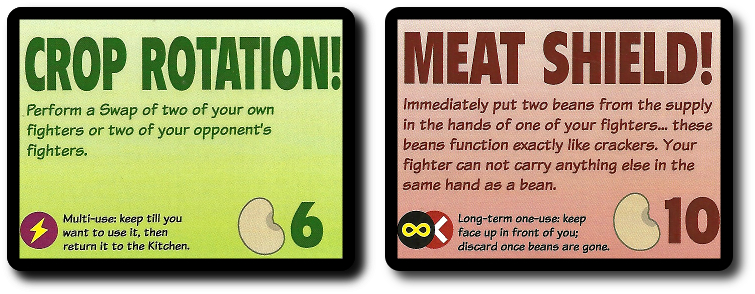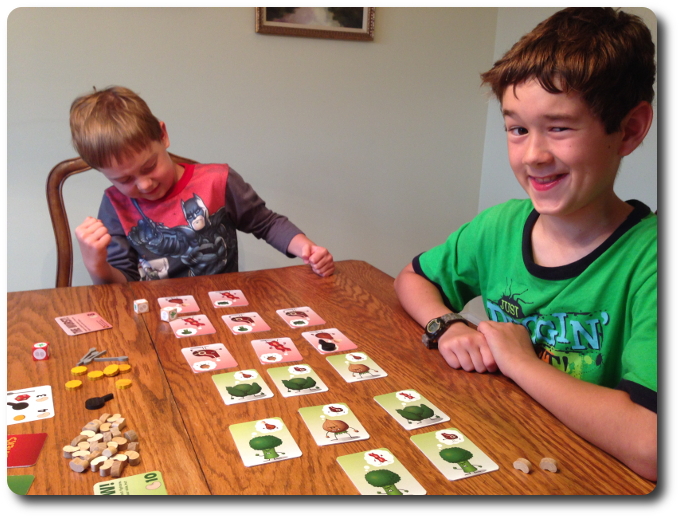Please Take Note: This is a review of the final game, but it might change slightly based on the success of the Kickstarter campaign. The game is being reviewed on the components and the rules provided with the understanding that “what you see is not what you might get” when the game is published. If you like what you read and want to learn more, we encourage you to visit the game publisher’s website or visit the Kickstarter campaign. Now that we have all that disclaimer junk out of the way, on with the review.

The Basics:
- For ages 7 and up (publisher suggests 8+)
- For 2 players
- Approximately 20 minutes to complete
Geek Skills:
- Counting & Math
- Logical & Critical Decision Making
- Reading
- Strategy & Tactics
- Risk vs. Reward
- Hand/Resource Management
- Bluffing and Misdirection
Learning Curve:
- Child – Easy
- Adult – Easy
Theme & Narrative:
- The final fight for food domination has begun!
Endorsements:
- Gamer Geek rejected!
- Parent Geek approved!
- Child Geek approved!
Overview
James Grover Thurber, a celebrated cartoonist, author, journalist, and playwright, wrote “The most dangerous food is wedding cake.” I wonder what he would say if he ever came face-to-face with a piece of broccoli holding a spear or a murderous slice of bacon! In this game, the players get to experience a food fight on a whole new level.
Foodfighters, designed by Josh Cappel, Helaina Cappel, and to be published by Kids Table Board Gaming, will reportedly be comprised of 18 Fighter cards (9 “Meat” Fighters, 9 “Vegetable” Fighters), 6 Power cards (3 “Meat” Power cards, 3 “Vegetable” Power cards), 1 Price card, 2 Pan tokens, 6 Cracker tokens, 4 Spoon tokens, 30 Bean tokens, 1 six-sided custom Bonus die, and 2 six-sided custom Normal dice. As this is a review of a prepublished game, I will not comment on the component quality. The illustration by Josh Cappel give each food fighter a bit of character, making the game’s theme all the more engaging. Ever see a chicken drumstick scowl in rage? It isn’t pretty.
Setting the Table
To set up the game, first split the Fighter cards into two groups: meat and vegetables. Both groups are identical (except for the Power cards). Each player takes 1 group.
Second, each player shuffles their Fighter cards and then deals them face-down to table to form a 3×3 grid. That is, 3 rows of 3 Fighter cards each. The furthest row from each player will be adjacent to each other. Once the Fighter cards are placed on both side, they are flipped over and remain face-up for the duration of the game.
Third, each player takes the Power cards that belong to their food fighter group and places them next to their rows, face-up. These Power cards can be purchased later in the game.
Fourth, take the dice, tokens, and Price card and set them to one side of the game playing area. Organize the tokens into piles to create the resource supply. Each player gets 3 Cracker tokens, 2 Spoon tokens, and 1 Pan token. The Beans and dice can remain grouped together, as they are shared.
When done with the above steps, your playing area will look similar to the following:

Image does not depict the game’s final artwork or components, although it is snazzy
That’s it for game set up. Determine who will go first and begin!
Everybody was Kung Food Fighting!!!!
Carl Douglas’s song is now in your head. You’re welcome.
Foodfighters is played in turns with no set number of turns per game. A player’s turn is broken down into 3 easy to follow steps that I will now summarize.
Step 1: Swap, Shift, Attack, or Roll for Beans
The player has 4 possible actions to choose from, but only 1 action can be taken per turn. Each action is summarized here.
Swap
The Swap action allows the player to change the position of any two Fighter cards that belong to them. The player announces which two Fighter cards are going to swap positions and then swaps them. The Fighter cards to be swapped can be in different rows and columns. Any tokens attached to the Fighter cards remain attached while being moved. After the Swap is completed, the player collects 1 Bean token from the supply.
Shift
The Shift action is similar to the Swap action, but is much more restrictive. Shift allows the player to change a Fighter card’s current position in a row by shifting it to any empty space in the same row it occupies. Again, any tokens attached to the Fighter card remain attached. After the Shift is completed, the player collects 1 Bean token from the supply.
Attack
There are only two rules that must be followed when declaring an attack. First, the Fighter card that is attacking must be “Thinking About” the Fighter card that it wants to target. If the little thought bubble that is rising from the food’s head doesn’t depict an image that matches the would-be target Fighter card, the attack cannot take place.
For example, the “Broccoli” Fighter card and the “Bacon” Fighter card are mortal enemies. Note how both foods are thinking murderous thoughts as they go into battle. They only have one goal on their little brains and that is to splat the enemy they are obsessing about. On a side note, it amuses me to think that broccoli and bacon hold a grudge against each other.

Additionally, the Fighter card can only attack the Fighter card directly in front of them or diagonally from them. This means that only the front row of Fighter cards will be doing the fighting when the game first starts.
If both the “Thinking About” and range is found to be legit, the player takes 2 Normal dice and rolls them. Every “Spat” rolled is considered a hit. A Fighter card without armor can only take 1 hit before it‘s removed from the game and collected by the player who slayed it. If the player should not roll any “Splats”, they collect 1 Bean token for every Bean image shown on the dice. If the player hits, they do not get to collect any Beans.
Of course, there are ways to circumvent the above rules of combat, which we will discuss in a moment.
Roll for Beans
This is similar to rolling for an attack, but this time the player only wants to roll Beans on the Normal dice. Any “Splats” rolled are rerolled. The player collects 1 Bean token for every Bean image shown on the dice.
Step 2: Spend Those Beans
Beans are the currency of the food world, apparently. Players use them to buy gear to equip their food army. What can be purchased is summarized here.
 Cracker Tokens
Cracker Tokens
Crackers are shields in the game. I love that. The player equips the Cracker token by placing it on the illustrated hand of one of their Fighter cards. This Fighter card is now protected. The first “Splat” it takes while in combat is absorbed by the Cracker token. After the Cracker token deflects the damage, it’s removed from the game.
Crackers cannot be purchased by the player if a previously equipped Cracker token was destroyed by the player’s opponent on their last turn.
 Spoon Tokens
Spoon Tokens
The Spoon tokens allow Fighter cards to extend their combat range. Normally, Fighter cards can only attack cards directly in front or diagonal from then. With the Spoon token equipped, the player can attack any card in front of them and any card diagonally from then, regardless of the distance. Like a mighty spear, the Spoon token is placed in a free hand of a Fighter card, showing the kitchen that this is one piece of food that should be taken seriously. But be warned. If the Fighter card with the Spoon token attacks an enemy Fighter card that is not in the front row, the Spoon token is removed and returned to the supply, regardless if the attack was successful or not.
Spoon tokens cannot be purchased by the player if a previously equipped Spoon token was used by them this turn during an Attack action.
 Pan Tokens
Pan Tokens
Pan tokens allow Fighter cards to temporarily forget who their mortal food enemy is. The Pan token is placed over the Fighter’s “Thought Bubble”, covering the image. This Fighter card can now attack any enemy Fighter card. Once the Fighter card successfully hits an opponent, the Pan token is returned to the supply.
Pan tokens cannot be purchased by the player if they successfully attack a target using a Fighter card with the Pan equipped.
 Bonus Die
Bonus Die
The Bonus die is rolled with the Normal dice. Its rolled value is added to the rolled result. This means it’s possible for a player to roll 3 “Splats” or a heck of a lot of Beans. The Bonus die can only be rolled once, however, and returns to the supply after it’s used.
The Bonus die cannot be purchased if it was just used by the player this turn.
Power Cards
Each player has their own set of unique Power cards. These give the player special abilities that can be used to tip the balance in their favor. The Power cards will either give the player a one-time use ability, a multiple-use ability, or generate an effect that lasts throughout the entire game. When and how the abilities are used is up to the player and defined somewhat by the Power cards.

Step 3: Opponent Fills Gaps
After the player takes their action and optionally spends some hard-earned Beans, their opponent fills in the gaps in their rows by bringing the Fighter cards from the furthest row back to the front row. Any gap is always filled with the Fighter card in the furthest row that is located in the same column. In this way, Fighter cards leapfrog each other and can cause a bit of a mess on the player’s front lines.
This completes the player’s turn. It’s now the opponent’s turn, starting with step 1 noted above.
Boxing Up the Leftovers
The game continues until one player collects 3 Fighter card of the same type from their opponent. These cards need not be collected in specific order.
To learn more about Foodfighters, visit the game publisher’s website or visit the Kickstarter campaign.
Final Word
The Child Geeks had a lot of fun with this game, both while playing it and making up names for the different foods portrayed on the Fighter cards. The army of choice was the “Meat” Fighters, which should come as no surprise since not many Child Geeks like their vegetables. According to one Child Geek, “I really like this game. I like how crackers are shields, spoons are spears, and pans are like helmets. Better yet, I really like that I can equip my bacon warriors!” Another Child Geek said, “This game is easy to learn and a lot of fun to play, but it makes you think. You cannot just attack if you want to win. You have to think about what you are doing.” Very true, but the depth of the game play was never complex enough to leave the Child Geeks scratching their heads. They always knew what they wanted to do next and how to go about it. They also knew, without hesitation, that Foodfighters was a game they all approved of.

My opponent is clearly pleased with his dice roll, while his older brother gives me a look of amusement
The Parent Geeks also enjoyed the game, finding it to be casual, entertaining, and containing just enough depth of play to make it a worthwhile use of their time. Their only disapproving remark was the number of players the game allowed at one time, but no one believed this was a mark against the game. According to one Parent Geek, “I am always disappointed when you teach us a new game that everyone likes, but only a few players can enjoy at a time.” Another Parent Geek said, “While I wouldn’t call this a combat game, it does have elements of strategic combat. The game is very well-balanced for new players and has enough in’s and out’s for more experienced players to tackle.” All the Parent Geeks enjoyed the game and voted to approve it.
The Gamer Geeks played Foodfighters and were not displeased, but nor were they overly impressed. According to one Gamer Geek, “The game is fine, but it’s not a game I would want to play. It’s too easy and too repetitive from my point-of-view.” Another Gamer Geek said, “A solid game, but not a Gamer Geek’s game. I think this is a perfect game for younger and less experienced players, but not for those of us who enjoy really deep game play.” And finally, another Gamer Geek said, “All of the fighters are the same, you are held hostage by the random values on the die, and you cannot move and attack fast enough to really develop a strategic and tactical plan. It feels like a kids game to me.” A few of the Gamer Geeks thought Foodfighters was a game they would enjoy playing with friends, family, and other gaming elitists as a game filler, but none of them believed Foodfighters was a game to be welcomed at the gaming elitist’s table.
Foodfighters is not a terribly difficult game or a deep one. It’s a hack and slash extravaganza with food. If it was just about smashing cards, I think the game would flop, but victory is not achieved by killing in mass quantities. This is a game about maneuvering in for the kill, baiting your opponent, and strengthening positions as quickly as possible before your opponent finds a weakness. That’s a lot to grasp in any game, but Foodfighters makes it all seem so simple. It’s the game’s simplicity that makes many roll their eyes when they first play it. It doesn’t take long for any player to quickly realize that there is more to this game than just rolling dice and counting beans.
But, still, it’s not that difficult of a game. And therein lies its greatest fault according to the gaming elitists. The game’s strategic and tactical game play is present, but not deep. Nor is there much of a need to over think anything in the game. It’s all there, in front of the players, right from the start. The only unknowns are the dice rolls and how your opponent will act or react to your moves. Which, as it turns out, was more than enough for the Child Geeks and the Parent Geeks.
Like the Gamer Geeks, the game did little to impress me. I understood the game’s goals and limitations after reading the rules and wasn’t surprised to see that my suspicions were confirmed after playing the game. But as a Parent Geek, I saw Foodfighters as a game I just knew my Child Geeks were going to enjoy. The game is fast paced, actions are meaningful, and there was just enough luck to offset skill. “Balanced” is what I would call it, at least from a Parent Geek’s point of view. And I was right, as the Child Geeks and Parent Geeks saw the same things I did.
Which, admittedly, makes me sound smug. The point is (beside the pride I feel when I guess correctly) is that Foodfighters pleased its intended audience. Furthermore, it didn’t win the support of the gaming elitists, but nor was it belittled. That, in my book, would suggest that Foodfighters is a well designed game, knows it’s target audience, and was crafted with enough skill to make the gaming elitists give it a nod of respect, if not admiration.
Not bad for a game about angry food.
If you like what you’ve read and are hungry for more, I encourage you to give Foodfighters a try. It wasn’t for everyone, but the majority ate it up.
This is a paid for review of the game’s final prototype. Although our time and focus was financially compensated, our words are our own. We’d need at least 10 million dollars before we started saying what other people wanted. Such is the statuesque and legendary integrity of Father Geek which cannot be bought except by those who own their own private islands and small countries.



